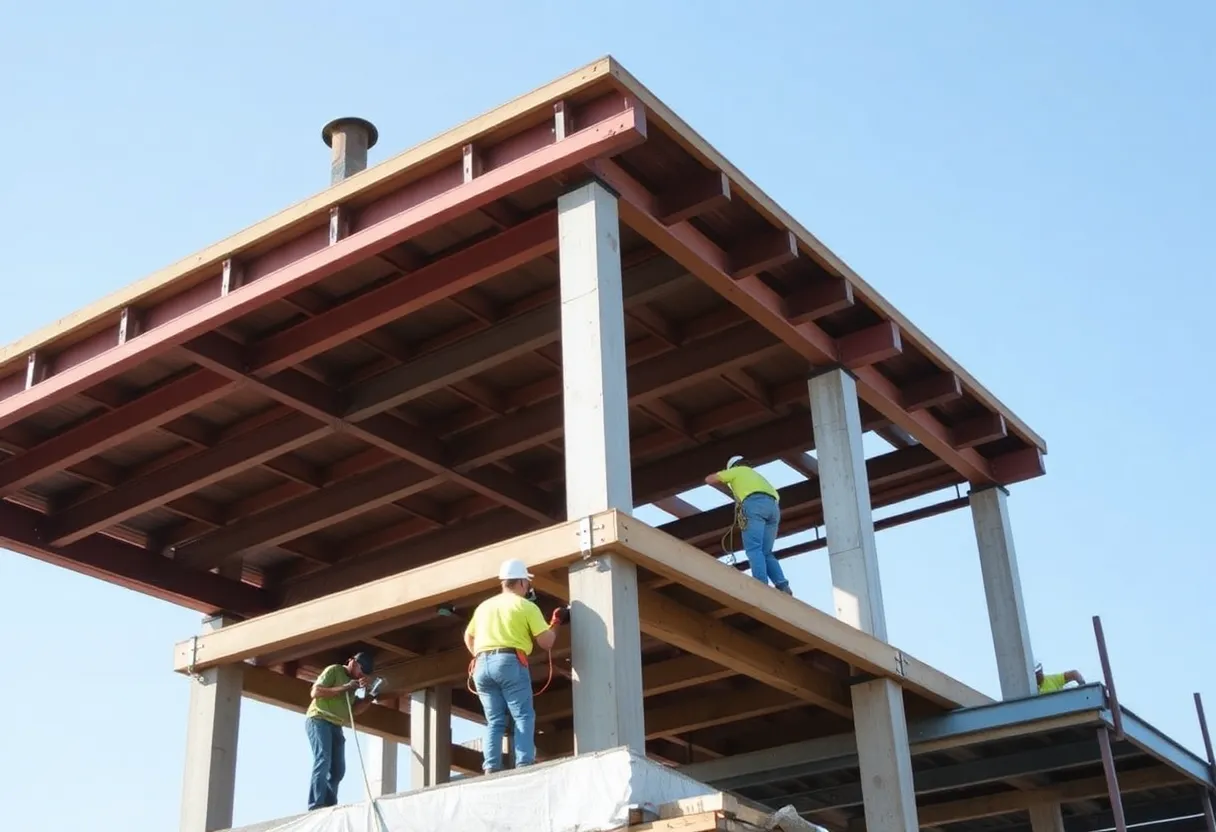Global, September 15, 2025
News Summary
A comprehensive market study forecasts rapid growth for construction collaboration software as the industry contends with tariff-driven cost swings, supply-chain volatility, regional consolidation and a sharp drop in New York City apartment starts. The 143+ page analysis projects the market to expand from about USD 2.4 billion to roughly USD 5.6 billion by 2033 at an 11.20% CAGR, highlighting cloud-based, BIM, mobile and AI-enabled collaboration tools. The report examines regional dynamics, vendor strategies, technology trends, and the operational pressures driving adoption as firms seek better coordination, risk management and schedule visibility.
New Global Study Maps Growth in Construction Collaboration Software as the Industry Grapples with Tariffs, Supply Risks and a Drop in NYC Apartment Starts
Key takeaway: A newly released, more-than-143-page market study lays out how digital collaboration tools for construction are set to grow rapidly over the next decade while the construction industry faces mounting pressure from tariff-driven cost swings, supply-chain shocks, regional consolidation and a sharp fall in apartment starts in New York City.
Top findings from the market study
The comprehensive analysis forecasts the global Construction Collaboration Software market to grow at a CAGR of 11.20% from 2025 to 2032, rising from about USD 2.4 billion in 2025 to roughly USD 5.6 billion by 2033. The study spans more than 143 pages and covers product and industry scope, market prognosis for 2025–2033, regional segmentation, market drivers and obstacles, as well as strategic profiles of major vendors.
What the study covers
- Type categories: Cloud-based collaboration, Project document management, BIM collaboration, Scheduling & task management, Cost tracking tools, and Mobile field collaboration.
- Application areas: Building & infrastructure, Civil engineering, Residential projects, Government projects, Architecture & design, and Industrial construction.
- Regional focus: The report identifies North America as the dominating region and Europe as the fastest-growing region, and it offers chapter- and region-wise breakdowns for markets including North America, LATAM, Europe, Japan, Australia and Southeast Asia.
- Vendors profiled include a range of global and regional software makers and platforms used across construction firms.
- Analytical tools used include a Five Forces examination and a PESTLE review.
Market trends, drivers and challenges
The study highlights several trends accelerating adoption: a shift to mobile-first collaboration platforms, tighter integration with project management and ERP systems, more use of AI for scheduling and risk prediction, development of industry-specific SaaS tools, and growth in real-time progress dashboards and API-based ecosystems. Key market drivers include the need for real-time collaboration among distributed teams, rising complexity of projects, the spread of BIM, and pressure to speed delivery and control costs.
Listed challenges include resistance from traditional firms to digital change, data security and confidentiality concerns, compatibility with legacy systems, and training and onboarding costs. Network reliability in remote locations and managing multi-stakeholder change are also noted barriers.
Why this matters now
The study appears amid wider pressures in construction: rapid tariff shifts, supply-chain volatility, and financing strain are forcing builders and developers to rethink contracts, schedules and material sourcing. The combination of rising material costs and tighter capital markets is pushing industry players to adopt tools that boost coordination, reduce rework and improve schedule visibility.
Industry moves tied to risk and consolidation
Regional consolidation and corporate reorganizations are under way to sharpen capabilities in tunnels, bridges, roadways and water systems. Several established contractors have been combined or restructured to create a single specialty firm aimed at regional infrastructure work, with a simplified structure intended to improve operations and risk management.
Tariffs, supply-chain stress and contractor risk
Recent shifts in trade policy and tariff uncertainty have pushed material prices higher and sped up how quickly costs can change. Iron and steel prices have risen significantly in the past year, and copper wiring and cable costs have also climbed. Developers are responding by buying materials early and paying for storage to guard against spikes. Contract language is being adjusted so that tariff and material-cost risk is shared or shifted, and some owners and builders are forming closer financial or operational partnerships to align timelines and costs. At the same time, working-capital stress has caused vendor and subcontractor failures, making contingency planning around subcontractor nonperformance more common.
New York City apartment market slump
Ground-up apartment construction in New York City has dropped sharply, with market-rate housing starts down substantially compared with recent years and the active construction pipeline contracting. Factors cited include a replacement tax and incentive regime with added labor and affordability requirements, high land prices, union wages and higher interest rates. Many investors have shifted to buying existing rental stock and pursuing office-to-residential conversions, aided by streamlined approvals for conversions.
What to watch
- Adoption rates of mobile and AI-enabled collaboration tools across contractors and owners.
- How firms renegotiate contracts to handle tariff shocks and who absorbs new cost categories.
- Further consolidation among specialty contractors focused on regional infrastructure.
- Policy shifts affecting the economics of new residential projects in major cities.
FAQ
What is construction collaboration software?
Construction collaboration software is a set of tools designed to help teams, contractors, architects and owners share documents, manage projects and communicate in real time. It covers planning, scheduling, budgets and field reporting to reduce errors and keep work on track.
How big is the market and how fast will it grow?
The market is estimated at roughly USD 2.4 billion in 2025, with projected growth to about USD 5.6 billion by 2033, driven by a forecasted CAGR of 11.20% between 2025 and 2032.
Which regions lead adoption?
North America is currently the largest region, while Europe is showing the fastest growth due to rising project complexity and demand for digital tools.
What are the biggest benefits for construction firms?
Benefits include better coordination among distributed teams, fewer mistakes, improved compliance with regulations, clearer cost tracking and faster problem detection through real-time dashboards.
How are tariffs affecting construction projects?
Tariff moves are increasing material costs quickly and unpredictably, prompting early purchases, on-site or off-site storage, contract rework to allocate risk, and new partnership approaches to align costs and timelines.
What causes the slump in NYC apartment starts?
High land prices, union wage costs, higher interest rates, and changes to tax and incentive programs that add labor and affordability rules have made many ground-up projects less attractive to developers.
Key Features at a Glance
| Feature | Details |
|---|---|
| Study length | 143+ pages of market analysis and forecasts |
| Market size (2025) | USD 2.4 billion |
| Projected market (2033) | USD 5.6 billion |
| Forecast CAGR | 11.20% (2025–2032) |
| Key product types | Cloud collaboration, BIM, document management, scheduling, cost tracking, mobile field tools |
| Top regional trends | North America leads; Europe fastest-growing |
| Major industry pressures | Tariffs, supply-chain volatility, financing stress, contractor consolidation, local policy changes affecting housing starts |
Deeper Dive: News & Info About This Topic
Additional Resources
- Bisnow: Developers & Builders — Whac-a-Mole with Macroeconomic Challenges
- Wikipedia: Construction management
- Construction Dive: Flatiron / Dragados SPC New York
- Google Search: Flatiron Dragados SPC New York
- Crain’s New York: NYC construction jobs still below pre-pandemic levels
- Google Scholar: NYC construction jobs pandemic
- The Real Deal: NYC apartment construction plunges
- Encyclopedia Britannica: New York City housing market
- ENR: Phase 2 contract awarded for NYC Second Avenue Subway
- Google News: Second Avenue Subway Phase 2
Author: Construction FL News
The FLORIDA STAFF WRITER represents the experienced team at constructionflnews.com, your go-to source for actionable local news and information in Florida and beyond. Specializing in "news you can use," we cover essential topics like product reviews for personal and business needs, local business directories, politics, real estate trends, neighborhood insights, and state news affecting the area—with deep expertise drawn from years of dedicated reporting and strong community input, including local press releases and business updates. We deliver top reporting on high-value events such as the Florida Build Expo, major infrastructure projects, and advancements in construction technology showcases. Our coverage extends to key organizations like the Associated Builders and Contractors of Florida and the Florida Home Builders Association, plus leading businesses in construction and legal services that power the local economy such as CMiC Global and Shutts & Bowen LLP. As part of the broader network, including constructioncanews.com, constructionnynews.com, and constructiontxnews.com, we provide comprehensive, credible insights into the dynamic construction landscape across multiple states.





